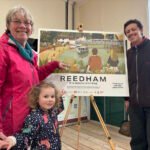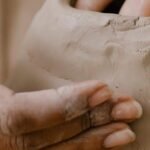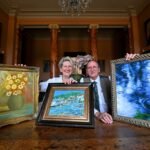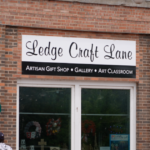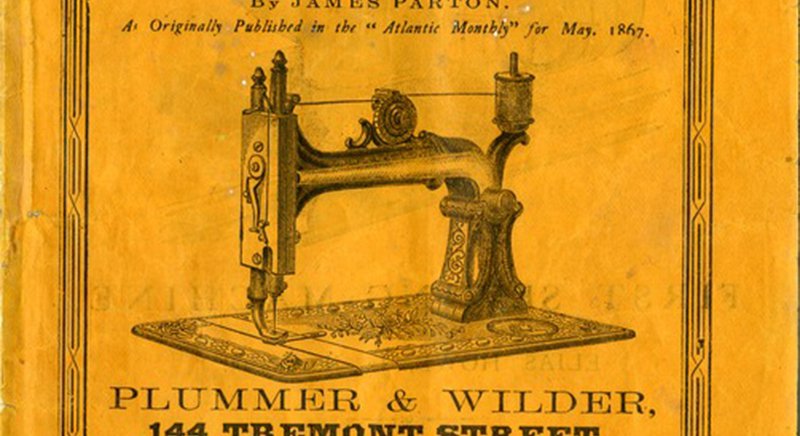

Digital Commonwealth Elias Howe’s 1846 sewing machine, as featured in a Scientific American Magazine in 1896.
The Inman Eats & Crafts Makers Market set for Sunday celebrates the many creative people and organizations that call Cambridge home. As part of the festival, History Cambridge offers visitors the opportunity to see the first commercially available sewing machine, invented in Cambridge by Elias Howe Jr. in 1846. Building on the work of inventors before him, Howe synthesized and perfected the machine that would streamline the labor of hand sewing and make possible the work of many of the artisans whose products will be on display at the Inman Market.
Howe was born on a farm near Spencer in 1819. He left the farm at age 16 and traveled to Lowell seeking to apprentice in a machine shop. After the financial panic of 1837, Howe lost his job in Lowell and moved to Boston, finding work in the shop of Ari Davis making mariner’s tools and scientific equipment. When an aspiring inventor brought a knitting machine into Davis’ shop, Davis advised the man, “Why are you wasting your time over a knitting machine? Take my advice, try something that will pay. Make a sewing machine.” The customer replied, “It can’t be done,” but Howe wasn’t so sure.
There were additional factors in Howe’s life that contributed to his interest in making a sewing machine. He was born with a physical disability that caused lameness and increasingly made his work as a laborer more difficult and painful. In 1843, when Howe was forced to pause from his work for a time due to chronic pain, his wife took in sewing to pay the family’s bills. Watching her work, he realized that the elusive sewing machine could solve all of his family’s financial and physical difficulties, and he dedicated himself to the project.
Financial limitations were Howe’s greatest obstacle, including a viable location, the necessity of buying supplies and finding time to dedicate to his burgeoning invention while still needing to provide for his family’s needs. Cambridge came to his rescue. Howe’s father had recently opened a factory in the city where Howe could set up shop for his own work. Unfortunately, the factory burned down not long after it opened, but Howe was saved by a generous and business-minded Cantabrigian named George Fisher. A friend of Howe’s, Fisher saw merit in Howe’s idea. Fisher agreed to house Howe and his family as well as investing $500 into the project in return for a half interest in the patent if one was obtained.

Digital Commonwealth A history of the sewing machine published in 1867 details Elias Howe’s invention and the creation of his company.
Howe had a machine by May 1845 that could sew seams. By July, he finished his first two suits of wool clothes, one for Fisher and one for himself. But to do more than his predecessors had been able to do, Howe had to interest the public in his machine. He put on a display – a race against five expert seamstresses working by hand – and his machine finished five seams before any of the seamstresses had finished one. The crowds remained wary, however, and the protests of the local tailors proved effective; Howe did not get a single order for his machine.
But Howe continued his work, finishing a second machine that was awarded a patent in September 1846. Fisher, his loyal investor, was growing frustrated after funding the project for more than two years without returns. Howe sent his brother, Amasa Howe, to England, hoping to find a more willing potential market. Amasa met William Thomas, a manufacturer of umbrellas, corsets and leather goods, and struck a deal in which Elias went to England to work on a new machine specifically adapted for corset-making. He sold one of his original machines to Thomas for 250 pounds sterling.
England quickly proved no better for Howe, however, and his troubles continued. He was never able to finish the adapted machine, and he sold what little he had managed to accomplish to Thomas for five pounds. Soon after, Howe got word from America that his wife was gravely ill. To earn enough money to travel back home, Howe pawned his remaining original machine and his patent papers. Once back in America, he suffered a terrible personal blow with the death of his wife, but in time realized that sewing machines had become popular in his absence. Even more shocking was that the machines being sold were based on his design. He quickly rebought his machine and patent papers from the London pawnshop and began to send letters to the suspected patent-infringers. This forced Howe into court, and his family and friends again came to his aid to help with the court costs. His two major cases were against Walter Hunt and Issac Singer, and he won both times. In the case between Howe and Hunt in the 1850s, the patent commissioner explained why Howe was deemed the rightful inventor of sewing machines despite Hunt having created a machine first:
“When the first inventor allows his discovery to slumber for eighteen years, with no probability of its ever being brought into useful activity, and when it is only resurrected to supplant and strangle and invention which has been given to the public, and which has been made practically useful, all reasonable presumption should be in favor of the inventor who has been the means of conferring the real benefit upon the world.”
Howe won the case, but as the sewing machine grew in popularity, all of the major manufacturers began to make increasingly similar machines. To avoid continual lawsuits over every new model, Howe reached an agreement with his competitors in 1856 to form a business “combination.” Four major patent holders all agreed that their parts could be used by the others. Additionally, Howe was to get royalties equaling $5 for every machine sold in the United States and $1 for every machine exported. Between 1856 and 1867, when the patent expired, this meant that Howe earned at least $2 million in license fees.
The sewing machine gained popularity quickly – first in Cambridge, then Boston, then nationally and internationally. As the country embarked on an industrial boom, Howe’s machine sped up the production of everything with stitching from umbrellas to tents, and proved especially transformational in the clothing industry. Ready-made clothing made owning a greater number of items of clothing possible. Increased efficiency meant cheaper costs of production, allowing for greater variety and experimentation in fashion. By 1900, sewing machines were making not only clothing, but awnings, tents, sails, cloth bags, book bindings, flags and banners, pocketbooks, trunks, valises, saddlery, harnesses, mattresses, umbrellas, linens, rubber belting and hoses for an aggregate sum of $979,988,413 for that year alone.
Howe died at age 48 in 1867, the same year his patent expired. Upon his death, his two sons-in-law carried on his business, but by the mid 1880s the Howe Machine Co. had gone out of business. The company of one of Howe’s earliest competitors, Isaac Singer, went on to dominate the sewing machine industry, and remains a household name today. Singer’s earliest machines owed much to Howe, and much of his success and early innovation took place in, and with the help of, Cambridge.
Visitors to the Inman Eats & Crafts Maker Market will have the opportunity to see Elias Howe’s original sewing machine, held in the collections of History Cambridge. We are pleased to partner with the East Cambridge Business Association and the many participating artisans to highlight the creativity of Cambridge past and present.
![]()
About History Cambridge

History Cambridge started in 1905 as the Cambridge Historical Society. Today we have a new name and a new mission. We engage with our city to explore how the past influences the present to shape a better future. We recognize that every person in our city knows something about Cambridge’s history, and their knowledge matters. We listen to our community and we live by the ideal that history belongs to everyone. Throughout 2025, we are focusing on the history of East Cambridge. Make history with us at historycambridge.org.
History Cambridge is a nonprofit organization. Our activities rely on your financial support. If you value articles like this one, give today.
Beth Folsom is programs manager for History Cambridge.
This post was updated May 6, 2025, to correct that the photo was not taken in East Cambridge.


